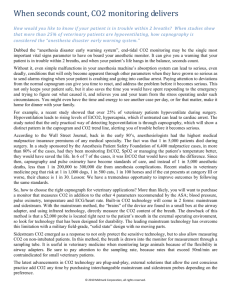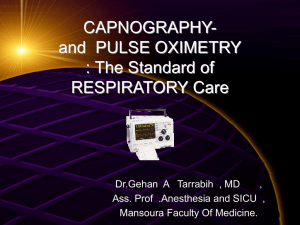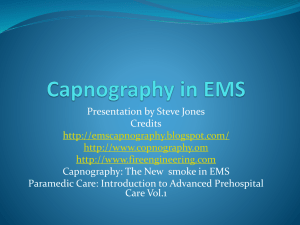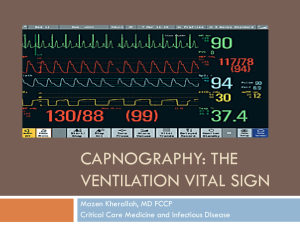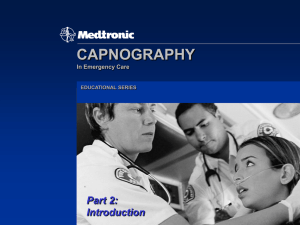Capnography
advertisement
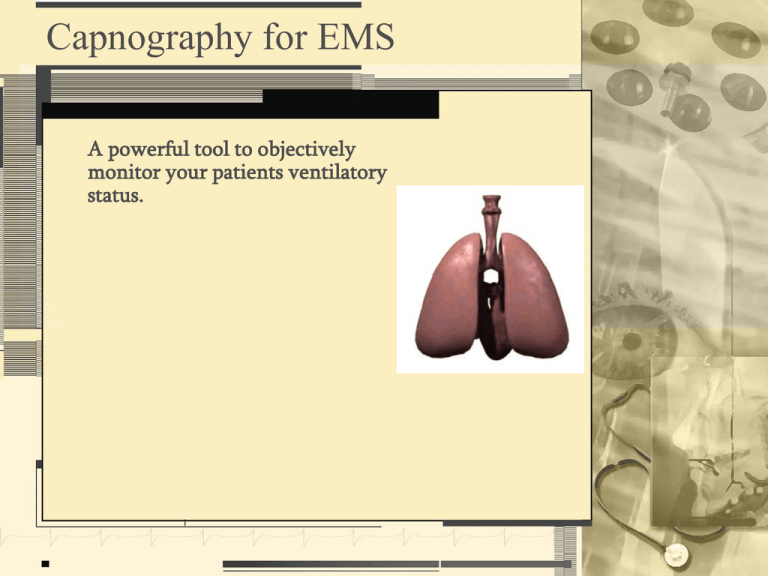
Capnography for EMS A powerful tool to objectively monitor your patients ventilatory status. Session Objectives • Define capnography and related terms • Compare capnography to other monitoring parameters • Describe the physiology behind capnography • Identify a normal capnogram and normal endtidal CO2 values • Identify abnormal waveforms • List the basic clinical applications in EMS Terminology: What is End Tidal CO2? • The non-invasive measurement of CO2 exhaled at the airway at the end of a breath • Normal values are 33-42 mmHg • (35-45 mmHg) “capnos” = smoke Terminology • Colorimetric – Disposable detector – Litmus paper – Color changes in the presence of CO2 Terminology • Capnogram – Graphical tracing or representation of exhaled CO2 at the airway – Waveform Terminology • Capnograph – Instrument – Monitor that provides a number and a waveform • Capnography Physiology of Carbon Dioxide • Oxygenation: The process of getting oxygen into the body and to the tissues for metabolism, is monitored with pulse oximetry. • Ventilation: the process of eliminating CO2 from the body, is monitored with capnography. Physiology of CO2 Oxygen -> lungs -> alveoli -> blood Oxygen breath CO2 lungs muscles + organs Oxygenation Ventilation Oxygen CO2 energy blood CO2 cells Oxygen + Glucose Physiology of Carbon Dioxide • Capnography can provide information about the profusion status. • Example: Low cardiac output caused by cardiogenic shock or hypovolemia wont carry as much CO2 per minute back to the lungs. ETCO2 will be reduced. Reduced perfusion to lungs causes this phenomenon. The Normal Capnogram A picture is worth a thousand words! Capnographic Waveform Zero baseline (A-B) End tidal value (D) Rapid, sharp rise (B-C) Rapid, sharp downstroke (D-E) Alveolar plateau (C-D) Phases of Exhalation • Beginning exhalation = no CO2 in breath • Middle exhalation = Rapid rise in CO2 • End exhalation – CO2 levels continue to gradually rise (alveolar plateau) – Peak just before inspiration (EtCO2) Clinical Applications: Airway • Verification of endotracheal tube placement – AHA Guidelines 2000 • confirm ETT placement with non-physical examination techniques including capnography • Controlled ventilation for sensitive to fluctuationNeonates and Mild Hyperventilation for Head injuries 30 mm. • Continuous monitoring of endotracheal tube position during transport (tube vigilance) • CPR – Effectiveness of cardiac compression/pacing – Earliest sign of ROSC – Predictor of survival- ETCO2 of 10 mm or less at 20 minutes had little chance of survival. Clinical Applications: Airway • I KNOW THE TUBE WAS IN BUT…. – Moved to gurney – Moved to/from ambulance – Moved to ER – CPR – Seizures – Agitation REQUIRED FOR ALL INTUBATED/COMBI TUBE PATIENTS!! Displaced Intubation • The ETCO2 will respond much faster to the displacement. • ETCO2 is a monitor of ventilation, SPO2 is oxygenation. 35 mmHg Non-Intubated Applications • Bronchospastic Disease • Hypoventilation States • Shock States • The list goes on… Phases of Acute Asthma Exacerbation Phase Clinical Assessment ETCO2 Levels Mild Hyperventilating <35 Moderate Tiring 40-50 Severe Tired >50 Acute Respiratory Diseases • Bronchospastic disease (Asthma, COPD) – Diagnose presence of bronchospasm – Assess response to treatment Clinical Applications: Breathing • • • • • • • Drug overdose ETOH overdose DKA Post ictal CVA Head trauma Neuromuscular Hypoventilation Syndromes Shock States • Precipitous drop or downward trending in the EtCO2 • Cardiogenic shock • Septic shock • Hemorrhagic shock (trauma) • Hypovolemic shock – Heat stroke Pulmonary Embolism 40 mmHg • Low EtCO2 with small waveform • Low SpO2 Pulmonary Hypo-perfusion What should you do with bagging? What should you do with bagging? What’s wrong with this waveform? What does this indicate on intubated patient? What’s happening with this non-intubated patient? Is your bagging OK? The Gear The Gear The Gear The Gear The Gear Summary: Capnography: The Ventilation Vital Sign • What can capnography monitoring do for you? – Confirm tube placement during intubation – Provide tube vigilance during intubation and transport with alarms – Identify ROSC during CPR,effective compressions, outcomes – NON-INTUBATED • Monitor breathing status of obtunded/sedated patients • Track progression of acute respiratory failure Summary



